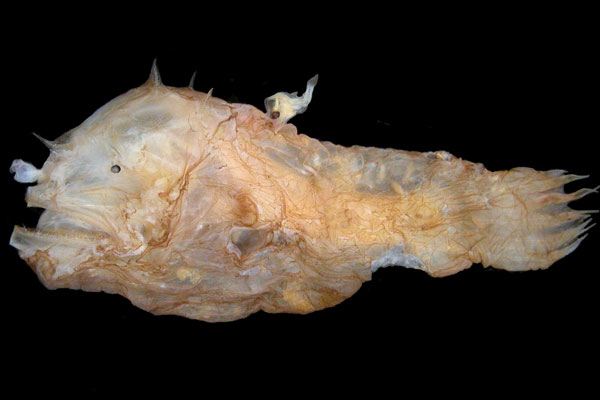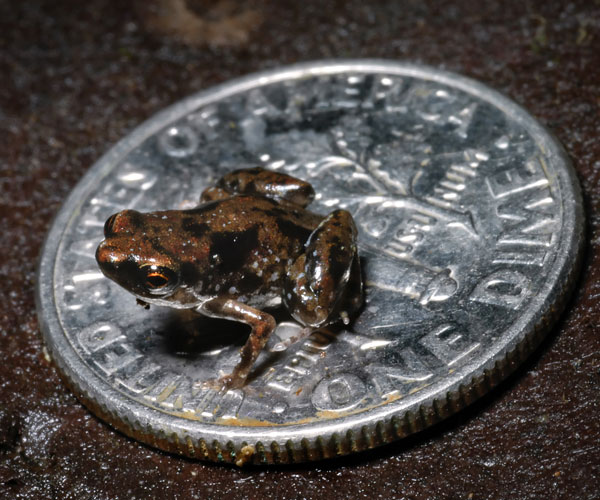Small Claims: Big Debate Over Tiniest Creature Title

Sitting end to end, two recently discovered frogs couldn't straddle a dime. Still, one scientist contends these diminutive creatures aren't record setting. Instead, he champions a tiny male fish for the title of smallest vertebrate, or animal with a backbone.
The contenders: A tropical frog Paedophryne amanuensis, which averages just 0.30 inches (7.7 millimeters) long, was given the "smallest vertebrate" title this week when news broke of its discovery Wednesday (Jan. 12). However, a male angler fish (Photocorynus spiniceps), which lives as a parasite on the angler-fish female and can measure as much as 0.03 in. (0.8 mm) less than the smallest of these tiny frogs, deserves the title, according to Ted Pietsch, curator of fishes at the Burke Museum at the University of Washington.
Turns out there's more than one way to measure a vertebrate, with the tiny frog's measurements referring to the average of mature individuals while the angler fish's size refers to the smallest individual of the species.
The smallest of the newly identified frog species measures 0.28 in. (7.0 mm) from the tip of its snout to its anus, or vent. The smallest of the parasitic male angler fish Pietsch described in 2005 measures 0.24 inches (6.2 millimeters) from snout to tail fin. [40 Freaky Frog Photos]
That's 11 percent smaller, Pietsch points out.
Christopher Austin, one of the herpetologists to discover and identify the tiny frog, is not impressed. "Our claim is this is the smallest vertebrate or species with a backbone. His might be the smallest vertebrate males in the world, but he excludes the large females that are about six times larger than our frog," said Austin, associate curator of herpetology in the Museum of Natural Science at Louisiana State University.
The 0.24-inch (6.2-mm) male angler fish was found grasping the back of a 1.8-inch (46-mm) female.
Sign up for the Live Science daily newsletter now
Get the world’s most fascinating discoveries delivered straight to your inbox.
"It's a good criticism except I never said it was a species, I said it was the smallest vertebrate, the smallest, sexually mature adult ever described among all vertebrates," Pietsch said.
This isn't the first time Pietsch put forward the angler fish as the rightful owner of the title. In 2006, when a newly discovered, swamp-dwelling Indonesian fish was heralded as the smallest vertebrate, Pietsch and the University of Washington countered with a press release touting the parasitic male angler fish.
"I think a lot of people learned from it," he said of the discussion he said ensued.
Define smallest

There's more than one way to rank size, points out James Albert, a biologist at the University of Louisiana at Lafayette, who has studied body size in fish.
"What is the smallest? Totally depends on how you measure. It's like asking which is the best baseball player? Hits? Runs? ERA [Earned Run Average]? You need a bunch of measures," Albert wrote in an email to LiveScience.
"Measured as the species with the shortest maximum snout-vent length in a sexually mature adult, well looks like P. amauensis wins. The largest Peadocypris pygmaeus (the tiny swamp fish) probably weigh less. The deep sea angler males are even shorter and lighter, but the genome of this species clearly allows for growth to much larger sizes," Albert wrote.
Lukas Rüber, a zoologist at the Natural History Museum in Berne, Switzerland, sided with the tiny frog, too.
"Forget about the angler fish. … We are talking about a parasitic male only that couldn't live on its own," Rüber told LiveScience in an email.
Not surprisingly, comparing different types of vertebrates can be dicey, since frogs, lizards, fish, birds and mammals are all shaped quite differently. Most biologists agree weight (or mass) is the best way to talk about size diversity, since mass is closely associated with measures of ecology and physiology, such as rates of cellular metabolism, genetic mutation rate, and molecular evolution, Albert wrote.
No debate about the weirdest
Regardless of size, the angler fish win the prize for strangeness. Angler fish live deep in the ocean, using lures to attract prey. Some of them reproduce by what is called sexual parasitism — meaning males latch onto much larger females, taking nutrients from her blood and supplying her with sperm, the maturation of which she controls, to fertilize her eggs. [10 Diabolical & Disgusting Parasites]
"Nothing else shares bodily fluids like this and tissue, it is quite extraordinary," Pietsch said.
Only male angler fish of the species Photocorynus spiniceps show such small sizes.
These fish are so rare that Pietsch based his work only three specimens. Pietsch dissected the smallest of these, the one measuring 0.24 in. (6.2 mm), to study its testes and make sure it was indeed a sexually mature adult with no more growing to do.
The tiny frogs found were all calling for mates, something only mature males do, according to Austin. Although no females were located, it's unlikely they differ in size from the males, since other species of Paedophryne also have diminutive females, according to Austin.
Why smallest matters
"The best part of the 'controversy' is it highlights some of the less-well known parts of biodiversity," Albert wrote.
Of the 60,000 vertebrate species living on Earth today, about half are fish and the rest land-dwelling vertebrates, he told LiveScience. "It is really interesting that both of these groups have scaled the small edge of the size spectrum, which seems to be about 0.28 to 0.31 inches (7 to 8 mm). Why this is the limit remains an open and fascinating question for evolutionary ecologists and ecophysiologists."
The discovery of the tiny frog was announced in a study published Wednesday (Jan. 11) in the journal PLoS ONE. Pietsch published his work in 2005 in the journal Ichthyological Research.
You can follow LiveScience senior writer Wynne Parry on Twitter @Wynne_Parry. Follow LiveScience for the latest in science news and discoveries on Twitter @livescience and on Facebook.











